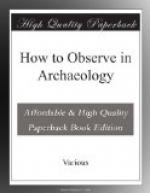Each traveller will require to provide for his special interests; but for any archaeological work the following things are desirable. Note-books of squared paper. Drawing-blocks of blue-squared paper. Paper for wet squeezes, and for dry squeezes. Brush for wet squeezes (spoke brush). One or two so-metre tapes. A few bamboo gardening canes for markers in planning. Divide one in inches or centimetres for measuring buildings. A steel rod, 3 ft. x 1 inch for probing. Field-glass, or low-power telescope. Prismatic compass with card partly black, to see at night. Large and small celluloid protractors for plotting angles on plans. Plotting-scale, tenths of inches and millimetres. Maps of the district, the best available. Aneroid barometer, if collecting flints; small size; can be tested by observing in a tall lift, or by putting in a tumbler and pressing the hand air-tight over the mouth. The zero error, or absolute values, are not wanted for levelling, only delicacy in small variations. Magnifiers, a few pocket size; will also serve for presents. Indelible pencils, pens, and ink in strong corked pocket bottle. Reservoir pens dry up too much in some climates. China ink for permanent marking. Strips of adhesive paper, about a inch and a inches wide, to put round objects for labelling. Strong steel pliers, wire-cutting. A few pocket-knives will serve for presents. It is best to carry money in a little bag or screw of paper, loose in the jacket pocket, it in a risky district. It can then be dropped on any alarm and picked up afterwards.
Photographic.[1] In the selection of a camera much will depend upon the nature of the work to be undertaken, the conditions of travel, and the climate to which the camera will be exposed. For accurate work a stand camera is always to be preferred to one of the hand variety, and care should be taken to choose an instrument that is strongly made and of simple construction. The essentials of a good stand camera are that it shall be rigid, possess a rising and falling front, a swing back, and bellows which will be capable of extension to fully double the focal length of the lens to be used with it.
[1]Prof. Petrie is not responsible for this section, which is due to the kind assistance of some professional photographers.-Ed.
The rising and falling front gives a power of modifying the field of view in a vertical direction. The swing back preserves the verticality of architectural subjects. In some cases, when used with the pivots vertical, it is a help in focussing the subject. The possible extension of the distance between the lens stop and the ground glass to twice the focal length (which is as a rule the distance between the same points, when a distant object is in focus) enables a small subject to be reproduced in natural size.




